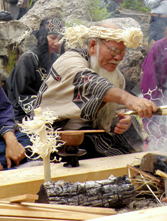Indigenous Japanese (Ainu) and Indigenous Australian
Cultural Exchange Australian Tour 2011
(Melbourne and Tasmania)
|
Brief History of the Ainu, an Indigenous People of Japan
|

The Ainu are the descendants of the Jomon People, who lived in the Japanese
Neolithic Age, which lasted approximately from 16,500 years ago to 3,000
years ago. The Ainu inhabited the northernmost main island of Japan, much
of Sahkalin and the Kurile islands. They called their homeland “Ainumosir”
in their language, meaning “the quiet land for humans.” The distinct Ainu
Culture emerged in the 13th century but the Ainu were gradually deprived
of their economic resources by Japanese feudal lords and merchants. They
lost social and political autonomy after a few major battles.
The Ainu fell under complete political control of the Meiji Government,
which came to power in 1868 and officially made “Ainumosir” part of the
Japanese territory in 1869, renaming it as Hokkaido. The Ainu land was
taken on the assumption that it was “terra nullius”, although Japanese
occupied only a tiny tip of southern “Ainumosir”.
The rest of their history is a story familiar to other indigenous peoples throughout the world -- dispossession, assimilation, crisis of survival, loss of culture, marginalization, discrimination, and in spite of these adversaries survival of culture, tenuous but obstinate.
The Ainu still concentrate in Hokkaido, so that the Ainu issue was and still is perceived as a local one, rarely being on the national agenda. Their population is often cited to be around 25,000 in government documents but it is common knowledge that there are many more who are reluctant to reveal their ethnic identity due to possible discrimination in marriage, employment, etc. There is no official statistics on minority populations in Japan. A moderate estimate of the Ainu population would be 100,000 with variations from 50,000 to even a million.
The Japanese government had adamantly refused to recognize the Ainu as an indigenous people. In 1987, the Japanese government view as indicated to the UN Working Group of Indigenous Populations was that the Ainu had been totally assimilated into mainstream Japanese society. In 1991 the government changed its view to admit that the Ainu were an ethnic minority but it still did not admit the Ainu were an indigenous people. The government’ excuse was that there was no established international definition of an indigenous people.
The UN Declaration on the Rights of Indigenous Peoples in 2007, which the Japanese government supported with an affirmative vote, did not immediately impact the government to change its official view on the status of the Ainu.
The real momentum for the recognition of the Ainu indigeneity came when the government decided Toyako Lake in Hokkaido, which was once the Ainu land, to be the venue for the G8 Summit to be held in July 2008. Moreover, the focus of the Summit was to be environmental issues, on which the Ainu, who had lived off the land and developed a sustainable lifestyle, had much to say. Further, a group of Ainu, mostly of the young generation, announced to hold an indigenous summit in Hokkaido to counter the G8 Summit.
|
 |
|
The political wind quickly changed and a bipartisan group of Parliament members submitted a resolution calling on the Government to recognize the Ainu as an indigenous people of Japan and establish the Ainu policy based on that recognition. |
| Indigenous Peoples Summit in Ainumosir 2008 |
|
The Parliament unanimously adopted the resolution, upon which the Government
issued a statement recognizing the Ainu indigeneity in June 2008, and promised
to start a process of reviewing the previous Ainu measures to formulate
the Ainu policy to formulate the Ainu policy.
The government established an expert panel in the following month, with eight members, of which only one was an Ainu, Tadashi Kato, who heads the Ainu Association of Hokkaido. After one year of deliberation, the panel came up with a report, recommending that the Government formulate a comprehensive Ainu policy covering not only the Ainu in Hokkaido but those who migrated to other parts of Japan. The measures recommended by the panel were acceptable to the Ainu, but they were framed in a political orientation of sidestepping the issue of indigenous rights. The panel report did not give any clue as to how the future Ainu policy would implement indigenous rights.
On the basis of this report, the Government set up the Panel on Ainu Policy Promotion, consisting of nine non-Ainu and five Ainu. At its first meeting held in January 2010, the Council prioritized the establishment of a large scale Ainu cultural facilities symbolic of a harmonious relationship between Ainu and non-Ainu and a survey on the Ainu throughout Japan. But again, the Panel was silent on the issue of indigenous rights.
Thus, in spite of the recent political development on the Ainu issues,
which by itself is historical in a country hitherto unsympathetic to minority
human rights, a long road still stretches ahead for the Ainu people to
get the Government to fully acknowledge the injustices done to the Ainu
and be awarded with indigenous rights, which are long overdue.
|
The Ainu in Greater Tokyo
The population of the Ainu living in Greater Tokyo (Tokyo and N neighboring prefectures) is estimated to be 5,000 to 10,000. They are migrants from Hokkaido and their children. Some left Hokkaido to live away from discrimination and others to find employment.
|
| Out of 5,000 to 10,000 Ainu living in Greater Tokyo, only a handful, less than 100, are actively engaged in Ainu cultural activities, without the support of central and Hokkaido governments which provide welfare measures to the Ainu in Hokkaido. The majority of the Ainu in Greater Tokyo would not reveal their Ainu identity because they are either afraid of discrimination or unable to find significance in Ainu identity. |
|
 |
|
back to TOP page |
|
|